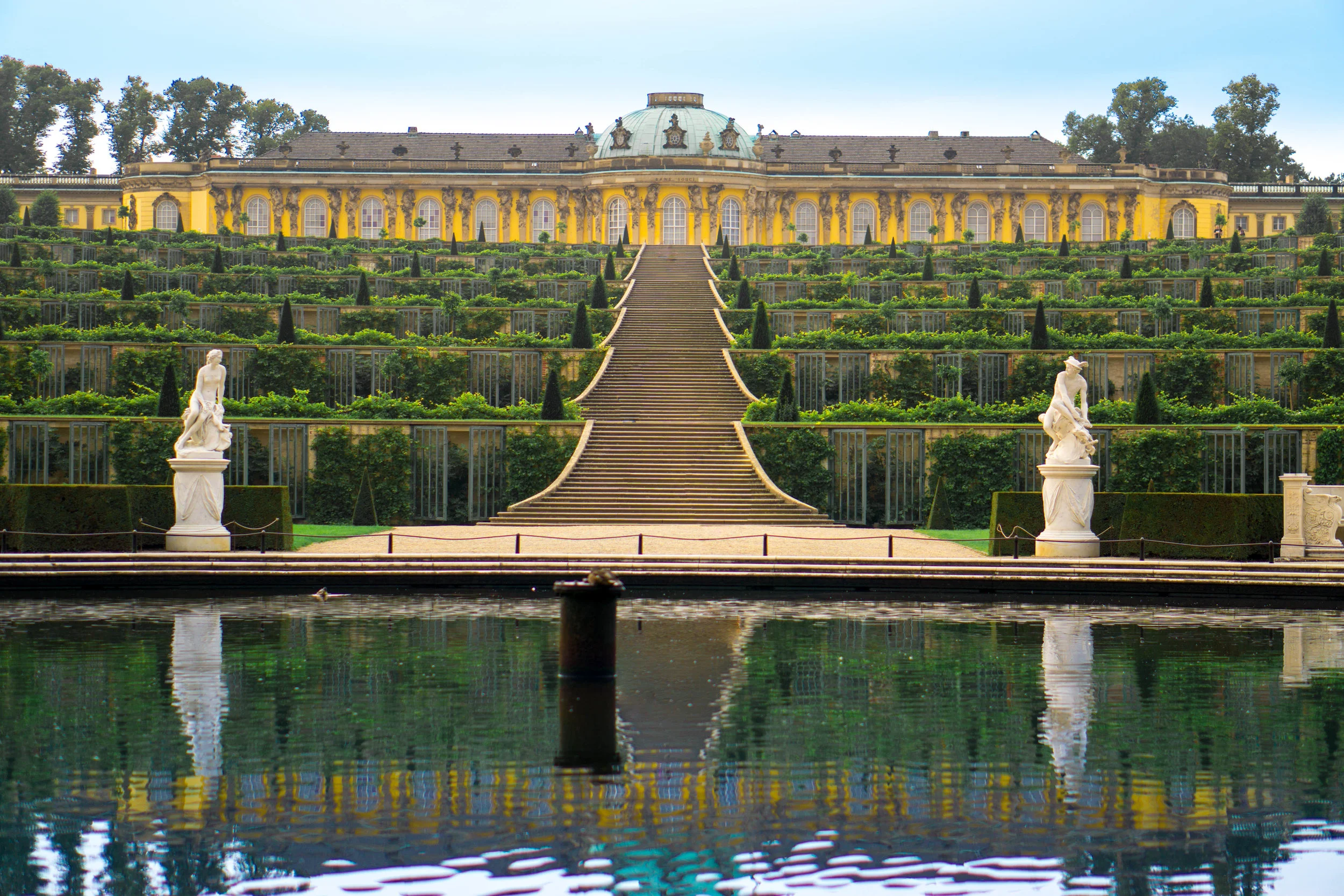Exploring Sanssouci Park in Potsdam
Potsdam is just a short train ride from Berlin, but feels a world apart. As we walked the streets to the train station after our day in the park, I commented to Gustavo that it reminds me more of Vienna than anything I’ve seen in Berlin.
It’s amazing how big Sanssouci Park is. I’ve been there twice now, and still feel like there’s much more to see. In fact, we’re planning to go back next week for another day of exploration. With that said, here are the basics on some of the major features of the park.
To get a better sense for the vastness and beauty of the park itself, check out our latest video! You can find that at this link.
Schloss Charlottenhof
We started off at Bahnhof Park Sanssouci, at the southwestern corner of the park. From here, you have two main options: head north to the 18th-century Neues Palais (New Palace), or east to Schloss Charlottenhof. We opted for the latter this time.
Charlottenhof Palace is a bit newer, built in the first third of the 19th century. It’s in such pristine condition that it’s hard to believe it’s almost two hundred years old. The well-maintained lake and lawns in front are also beautiful, and would be the ideal spot to have a picnic.
The inside is open to the public, but requires a ticket. I’ve heard wonderful things about it, but there was so much we wanted to see in the park that we chose to continue on without touring the inside (this time!).
The Roman Baths
Despite the name, Potsdam’s Roman Baths aren’t actually thousands of years old and weren’t used by the ancient Romans. Instead, they were built just a few years after Charlottenhof Palace, in the 1830s. The inside is said to incorporate numerous Roman architectural style choices to evoke a sense of an ancient bath house. Again, though, we chose to appreciate it from outside.
It’s easy to imagine yourself in Italy, and hard to imagine that this building and Charlottenhof Palace were commissioned by the same person (Crown Prince Frederick William) around the same time. The Roman Baths are charmingly, perfectly rustic, with vines growing across the walls and trellises and flowers everywhere.
The Chinese House
Somewhat unintentionally, we also stopped by the Chinesisches Haus. Built in the mid-18th century, it’s so charming that it almost looks like something from a fairy tale (or a tasteful theme park) more than something you’d actually find in a public park.
One of the things I love about Sanssouci Park is the incredible range of stunning architecture in such different styles. The Chinese House was commissioned by Frederick the Great and shamelessly celebrates the style of Chinoiserie, combining Asian elements with European stylistic preferences.
The building is this odd shade somewhere between robin’s egg, mint, and turquoise (it’s much prettier than it sounds). Its surrounding pillars and statues are lavishly, ornately gold, vibrant against the greenish backdrop. Isn’t it somehow reminiscent of a merry-go-round?
Sanssouci Palace
We finally reached our ultimate destination, Sanssouci Palace, several hours after we entered the park. The name, if you take it simply, translates as “without worries.” The clearly deliberate insertion of a comma between the words where they show up on the palace itself, though, gives it a potentially more ominous meaning. There has apparently been an entire book written on the question of this comma, but my German isn’t (yet!) up to the task of reading it, and it doesn’t seem like there’s an English translation.
The palace was built in the mid-18th century for Frederick the Great, and stands the test of time as a magnificent, breathtaking building even today. Despite having been here twice now, I haven’t yet made it inside -- not because I’m not interested, but because the surrounding area is so beautiful that, both times, I’ve been distracted until it’s too late and the palace is closed.
Everywhere you turn is another fascinating, and often beautiful, detail. From the architecture of the palace itself, to the tiers of grape vines and fig trees, to the multitude of flowers, to the occasional odd detail (including one of the ugliest gargoyle-like faces I’ve ever seen on a building), the palace is absolutely captivating.
Nearby, we came across Frederick the Great’s grave purely by chance. This was covered in potatoes, which baffled us both at the time. Since then, I’ve come to learn that the reason is that Frederick brought potatoes to Prussia. In gratitude, apparently people still leave potatoes all over his grave.
Getting to Sanssouci Park
Getting to Park Sanssouci from Berlin is surprisingly easy. It’s in the C zone, so a standard ABC ticket is all you need. There’s no extra charge to go to Potsdam regardless of whether you take the S-Bahn or one of the regional trains.
The S1 goes straight to the Potsdam Hauptbahnhof. The faster option, though, is to take one of the regional trains. Several options include the RE1, RB21, and RB 22. All three of these stop at each of the three main stations in Potsdam.
Bahnhof Park Sanssouci is the nearest to the park itself, though it’s at the opposite end as the famous Schloss Sanssouci, or Sanssouci Castle.
Final Thoughts
Have you been to Sanssouci Park? As I mentioned, we're planning to go back since there's still so much we haven't seen there. We'd love to hear your recommendations!
If you haven't already, follow us on Instagram, where we share pictures of our adventures. Finally, as I mentioned, don't miss our video of Sanssouci Park!
